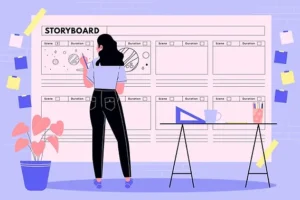With the rise of video consumption increasing every year on the internet, nearly everyone now incorporates video into their marketing strategies. Years ago, simply having a video to promote your products or services was enough to set you apart. However, in today’s digital landscape, video is so widespread that standing out requires more than just having one.
Your video content must offer something unique, something memorable that makes your audience and clients remember you. And how is that achieved? Through high-quality production.
Here’s a breakdown of the workflow we follow to achieve this goal.
Phases of Video Production
Phase 1: Briefing
A solid briefing with the client is essential. By the end of the briefing, there are four key aspects we need to have clarified:
- Purpose: What is the purpose of the video?
- Promotional, educational, a call-to-action, sales tool, part of an online loyalty strategy, or branding?
- Target Audience: Who is the video aimed at?
- Distributors, end customers, social media users, etc.
- Platform: Where will the video be published?
- Internal use, TV commercial, or an online platform?
- Budget: What resources are available?
- It’s important to know the estimated budget to determine what’s feasible. While some companies have unlimited resources, most projects require working within specific constraints.
Once these questions are answered, you’ll have a clear framework to proceed. Including references to other videos that inspire or align with your goals is also highly beneficial.

Phase 2: Creativity
Creativity is one of the most important phases of video production. This is where the differentiating element of your video will emerge.
Using the established resources, you’ll craft the project in the most dazzling way possible.
Example:
If tasked with introducing a new snack product, instead of simply listing its features or describing its creation process, you could present it in a humorous, memorable way that makes it unforgettable.
Creativity involves exploring concepts, testing ideas, rewriting, and reimagining until you land on the perfect structure or perspective. This effort is what makes your video stand out.

Phase 3: Pre-production
With the concept and script finalized, the next step is pre-production. This phase involves organizing the shoot to optimize time and budget effectively.
Key steps in pre-production include:
- Hiring technical and artistic teams.
- Scheduling shoot dates.
- Reserving necessary equipment.
- Storyboarding key scenes.
- Choosing filming locations.
- Setting project timelines and milestones.
Good pre-production ensures a smooth shoot and reduces the risk of unexpected issues.

Phase 4: Filming
The filming process can vary in complexity, length, and scope depending on the project’s resources and goals.
Tips for Successful Filming:
- Focus on capturing the essence of your concept.
- Ensure production values align with the idea, prioritizing quality where it matters most.
- Collaborate closely with the client during the shoot to ensure their satisfaction with the footage.
While having advanced equipment and ample time is ideal, a well-executed concept with adequate resources often has a greater impact than a generic project with excessive production.
Phase 5: Post-production
After filming, the final phase is post-production. This involves polishing the raw footage and adding the finishing touches.
The key steps in post-production include:
- Editing
- Cutting and arranging footage to craft the final narrative.
- Reviewing multiple drafts internally and with the client to refine the final product.
- Sound Design
- Adding sound effects and music to create the right tone and atmosphere.
- Ensuring audio quality is polished, as sound is 50% of the video experience.
- Special Effects (FX)
- Adding elements like green screen effects, object removal, or motion graphics.
- Color Correction
- Equalizing color, contrast, and brightness across all footage.
- Adding a final visual style to align with the narrative or aesthetic goals.
- Graphics and Animations
- Designing and animating titles, text, or other graphic elements in 2D or 3D as required.
After completing post-production, the video is exported in the necessary formats and delivered to the client.






